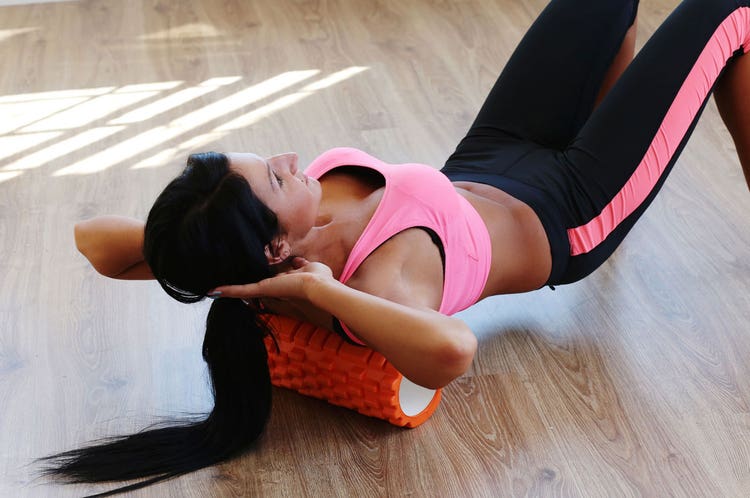Fascia, Unwrapped

There’s a lot of buzz about fascia out there. You may have heard about myofascial release with foam rollers, myofascial therapies (like Rolfing) or even how to keep our fascia healthy — but do you really know what fascia is and why it’s such a hot topic?
WHAT IS FASCIA?
The short answer is that fascia is a web-like connective tissue that surrounds every cell in our bodies. It holds us together in a state called tensegrity, and it affects how our bodies feel, how we move and even how we look. And our muscles, ligaments, tendons, blood, skin, and fascia make up the myofascial network, which basically holds our bodies in shape.
Once we understand more about what fascia is and how it responds to repetitive stress, it becomes clear that we have to move. (And when Mom warned you not to make that face again or it could get stuck, she might have been exaggerating, but she was onto something.)
FASCIA CAN CHANGE
The elastic and flexible nature of our fascia is vital to everything we do. When we run, our fascia’s elasticity helps our muscles relax quickly so that we can take our next step smoothly. It lets us bend and breathe into all our favorite yoga poses. Smiles and frowns aren’t just facial expressions: they’re fascial expressions, too.
When our body does one thing repetitively, like sitting or texting, layers of fascia build up around specific areas to prevent injury. This can create restricted movement, tightness and pain. Chronic low back pain is associated with thicker, more numerous fascial layers in the low back. Tight hips often result from too much sitting. We get unsightly and uncomfortable text neck from looking down too much.
Fascial build-up like this tells us two important things. First, modern life is not set up to promote fascial health. Second, fascia is affected by how we move. Which means we can change it. Just as repetitive movements can build fascia in an unhelpful way, we can change how we move to help us remodel our fascia in ways that make us stronger and more flexible. How? The key is multi-directional movement.
FACIA IS…EVERYWHERE
Fascia surrounds every cell, organ, artery, muscle fiber, vertebral disc – everything! And the more we learn about fascia, the less separate all these different parts seem. For example, we often say that muscles attach to tendons and tendons attach to bones. But the fascia that surrounds muscle segments is the same stuff as the tendon. So really, muscle becomes tendon and tendon becomes bones as the fascia changes shape and texture.
And fascia changes a lot. In some places it is a dense mesh, in others it is an open web of fibers. In still other places, it forms sheets, layers and tube-like sheaths. This variety means fascia can take on different roles. In our feet, it acts as a shock absorber, distributing the impact of each step into multiple tissues to protect our knees and low back.
Regardless of shape or location, fascia is made mostly of collagen and water. Lots of water. Did you ever hear that humans are 70 percent water? Our fascia is holding on to most of that water for us. Like a wet sponge, it stretches, twists, compresses and springs back into shape. Dehydrated fascia is just like a dried-out sponge: stiff and fragile. If you needed another reason to drink water throughout the day, this is it!
JOINTS ARE NOT JUST LEVERS
In school, we learn a basic model of human structure: bones are connected like hinges that are moved by our muscles. This way of thinking about the body helps us understand the basics of single-joint mo-tions like bending our elbows or straightening our legs.
But this model doesn’t represent some of the most amazing things our bodies can do, like breakdancing or sprinting with a soccer ball to score the winning goal. In fact, when scientists use this single-joint model to examine complex weightlifting (like a snatch), the math doesn’t make any sense. Calculations using this model result in forces so strong, they would tear our muscles and crush our bones. But we see people lifting weights without falling apart, every day. So how are our bodies able to do the impossible?
WHAT PULL US APART KEEPS US TOGETHER
Tensegrity is an architectural term for a structure that supports itself by balancing tensile (lengthening) forces and compression (shortening) forces – like the child’s toy made of strings and sticks that pull on each other to hold everything in place.
Biotensegrity applies the concept to our understanding of our own bodies. In this model, our skeleton is held within a 3D matrix of muscle and connective tissue called the myofascial network.
This network contains two main types of tissue:
- Contractile: Muscle tissue. It contracts to move our bones around our joints.
- Elastic: Connective tissue, like fascia, tendons and ligaments. It stretches and snaps back, much like a rubber band. We used to believe it only held things together, but we now know that this elastic action generates some of our movement, too.
These two tissues pull on each other and our bones to hold us in shape, like the sticks and strings in a tensegrity toy.
We know that we need strong muscles for good posture, easy movement and power during our favorite activities. Biotensegrity tells us that all of these things require strong connective tissue, too. And that’s why fascia is so important.